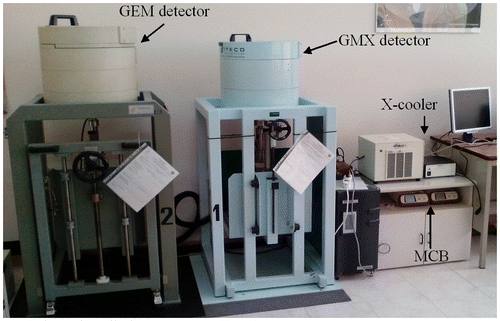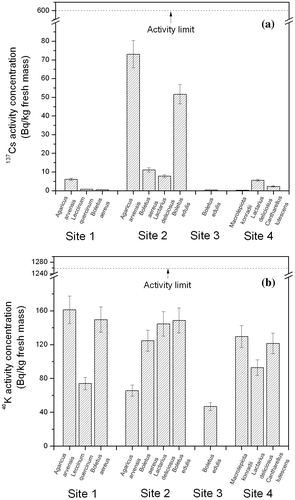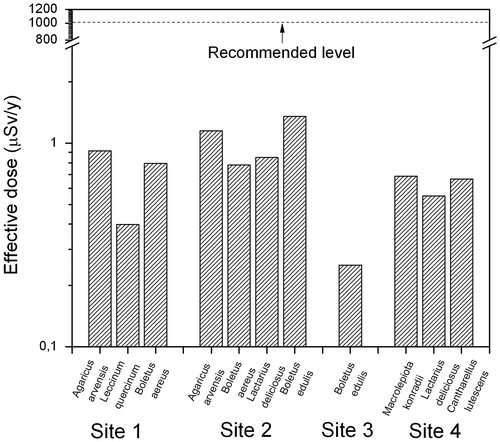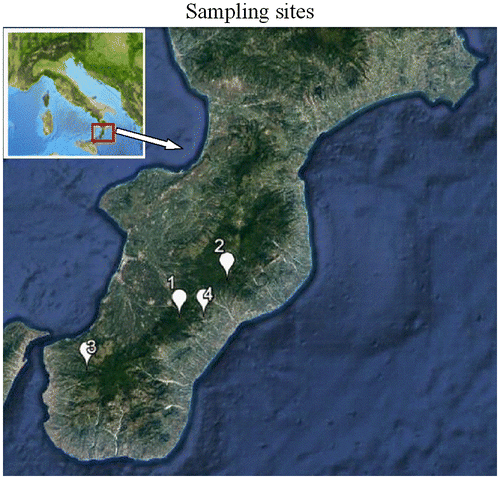 ?Mathematical formulae have been encoded as MathML and are displayed in this HTML version using MathJax in order to improve their display. Uncheck the box to turn MathJax off. This feature requires Javascript. Click on a formula to zoom.
?Mathematical formulae have been encoded as MathML and are displayed in this HTML version using MathJax in order to improve their display. Uncheck the box to turn MathJax off. This feature requires Javascript. Click on a formula to zoom.Abstract
Wild-growing mushrooms are a complementary foodstuff, widely consumed as a delicacy, in Italy. They are considered excellent bioindicators of environmental pollution and the accumulation of radionuclides can pose a radiological hazard. 137Cs and 40K activity concentrations were measured through HPGe gamma-spectrometry in different mushroom species (Agaricus arvensis, Leccinum quercinum, Boletus aereus, Lactarius deliciosus, Boletus edulis, Macrolepiota konradii, Cantharellus lutescens) collected from four different sampling sites in the Calabria region, south of Italy. Experimental values were found to be in the range from (0.3 ± 0.1) Bq/kg f.m. (fresh mass) to (73.1 ± 4.6) Bq/kg f.m. for 137Cs and from (46.9 ± 10.7) Bq/kg f.m. to (161.3 ± 12.9) Bq/kg f.m. for 40K, respectively. All values were much lower than the specific activity limit set by the international legislation at 600 Bq/kg f.m. for 137Cs and at 1,258 Bq/kg f.m. for 40K, respectively. Experimental activity concentrations allowed us to determine the effective dose due to the ingestion of mushrooms by adult members of the population. It was found in the range from 0.25 to 1.35 μSv/y, much lower than the recommended level for the public (1 mSv/y). Data obtained in this article provide useful information on the environmental risk and can be further used for a radiological mapping of the studied area.
Public Interest Statement
The main aim of this work is to investigate about the radioactivity content in wild-growing mushrooms, a complementary foodstuff widely consumed as a delicacy, collected from four different sampling sites in the Calabria region, south of Italy. They are considered excellent bioindicators of environmental pollution and the accumulation of radionuclides can pose a radiological hazard. 137Cs and 40K activity concentrations were measured through high-resolution gamma-spectrometry in different mushroom species (Agaricus arvensis, Leccinum quercinum, Boletus aereus, Lactarius deliciosus, Boletus edulis, Macrolepiota konradii, Cantharellus lutescens) and experimental specific activities allowed us to determine the effective dose due to the ingestion of mushrooms by adult members of the population.
Data obtained, in this article provide, useful information on the environmental risk and can be further used for a radiological mapping of the studied area.
1. Introduction
Mushrooms are considered excellent bioindicators of environmental pollution, since they bioaccumulate heavy metals (Horyna, Citation1991; Kalac, Citation2010). Most radionuclides, whether anthropogenic or naturally occurring, being also heavy metals can be bioaccumulated by mushrooms and, thus, their contents can pose a health hazard, mainly in areas heavily contaminated by radioactive fallout (Caridi, Belvedere, D’Agostino, & Marguccio, Citation2017; Caridi, D’Agostino, et al., Citation2017).
The analysis of the radioactive content of mushrooms reported in literature was mainly focused on radiocesium, a long-lived anthropogenic radionuclide (T1/2 = 30.2 years) chemically analog of potassium and released into the environment by atmospheric nuclear weapons tests and various accidents involving nuclear materials (Caridi, D’Agostino, et al., Citation2016), and on 40K, because mushrooms contain between 1.5 and 117 g of potassium per kg of dry matter and, thus, its levels in many species are considerably higher than those in foods of plant origin (Júnior, Cardoso, Silva, Silveira, & Amaral, Citation2006; Seeger & Schweinshaut, Citation1981). Other anthropogenic (90Sr, 239+240Pu, 241Am, etc.) and natural (uranium and thorium daughter products) radionuclides were less studied, because their content and radiological impact rarely surpass those of 137Cs and 40K (Lux, Kammerer, Ruhm, & Wirth, Citation1995; Mietelski et al., Citation2002; Wichterey & Sawallisch, Citation2002).
The main objective of the present work was to estimate the anthropic and naturally occurring radionuclide content of wild-growing mushrooms from the Calabria region, south of Italy, in order to assess whether they may pose a health hazard like complementary foodstuff, widely consumed as a delicacy mainly by the local population. Radionuclides content depends on several parameters, including the level of radioactive fallout or naturally occurring radionuclides in the environment, the mushroom species, its nutritional mechanism, mycelium depth (the substrate from which the mushroom takes up nutrients together with radionuclides), climate, and bioavailability of the radionuclide (Skuterud, Travnikova, Balonov, Strand, & Howard, Citation1997). In order to compare our experimental data, reported for samples fresh mass, with the literature ones obtained for dry mass, a dry/wet ratio of 0.1 was used, according to the mean value reported in literature (Baeza et al., Citation2004).
2. Materials and methods
Five samples of 1 kg each for every different species of wild-growing mushrooms (Agaricus arvensis, Leccinum quercinum, Boletus aereus, Lactarius deliciosus, Boletus edulis, Macrolepiota konradii, Cantharellus lutescens) were collected in four sampling sites of the Calabria region, south of Italy: site 1 (GPS coordinates: 38°21′43″ N, 16°14′24″ E), site 2 (38°02′41″ N, 15°54′00″ E), site 3 (38°10′06″ N, 15°47′21″ E), and site 4 (38°18′50″ N, 16°11′59″ E).
The map of the sampling points is reported in Figure .
All samples were homogenized, after the removal of not edible parts, prior to be inserted in Marinelli containers of 1 L capacity for the Gamma-Spectrometry analysis. They were counted for 70,000 s and spectra analyzed to obtain the activity concentration of 137Cs and 40K through the evaluation of their γ-line at 661.66 keV and 1,460.8 keV, respectively. The uncertainty is given at the 95% confidence level.
The experimental setup is composed by two Ortec HPGe detectors and integrated digital electronics. The first is a negative biased detector (GMX) with FWHM of 1.94 keV, peak to Compton ratio of 65:1, and relative efficiency of 37.5% at 1.33 MeV (60Co). The second one is a positive biased detector (GEM) with FWHM of 1.85 keV, peak to Compton ratio of 64:1, and relative efficiency of 40% at 1.33 MeV (60Co). Detectors were shielded from environmental background, using lead shields with copper and tin lining. Efficiency and energy calibrations were performed using Eckert and Zigler Nuclitec GmgH traceable multinuclide radioactive standards, number SV 277, covering the energy range 59.54–1,836 keV, customized to reproduce the exact geometries of samples in a water-equivalent epoxy resin matrix.
The Gamma Vision (Ortec) software was used for data acquisition and analysis (Caridi, Marguccio, et al., Citation2016). In particular, an appropriate library containing key information (energy, half-life, etc.) about the radionuclides present in the investigated samples was employed to identify them in the spectrum and then to perform correction and activity calculations.
A photo of the experimental setup is reported in Figure .
Figure 2. A photo of the experimental setup, with the HpGe GMX and GEM detectors, the X-cooler and the PC plug-in Multi Channel Buffer (MCB) put in evidence.

The activity concentration of 137Cs and 40K was calculated using the following formula:(1)
(1)
where NE indicates the net area of the peak at energy E = 661.66 keV and E = 1,460.8 keV for 137Cs and 40K, respectively; εE and γd are the efficiency and yield of the photopeak at these energy values, respectively; M is the fresh mass (f.m.) of sample (kg) and t is the live time of the apparatus (s).
A possible risk of radioactivity for human health is expressed by the total annual effective dose due to the ingestion of wild-growing mushrooms, on the basis of the activity concentration and dose conversion factor of the selected radionuclides:(2)
(2)
where Y = annual intake of mushrooms (kg f.m. per person), C = activity concentration (Bq/kg f.m.), and dk = dose coefficient (conversion factor) defined as the dose received by an adult per unit intake of radioactivity, equal to 1.3 × 10−8 Sv/Bq and 6.2 × 10−9 Sv/Bq for 137Cs and 40K, respectively (Italian Legislative Decree 230/95, Citation1995 and s.m.i.).
3. Results and discussion
The activity concentration of 137Cs and 40K for the wild-growing mushrooms collected in the investigated sampling sites is reported in Table . Errors given in Table are the standard deviations of five samples of each mushroom specie measurements.
Table 1. The activity concentration of 137Cs and 40K for the wild-growing mushrooms collected in the investigated sampling sites
Several differences can be noted. For example, the highest 137Cs content was found in A. arvensis, (73.1 ± 4.6) Bq/kg f.m. in the sampling site 2, while the M. konradii in the sampling site 4 had the lower cesium activity, (0.3 ± 0.1) Bq/kg f.m. Furthermore, in the case of A. arvensis the specific activity of 137Cs was measured in two different places: site 1 (6.1 ± 0.5 Bq/kg f.m.) and site 2 (73.1 ± 4.6 Bq/kg f.m.); for B. aereus the activity concentration of radiocesium was measured in the site 1 (0.5 ± 0.1 Bq/kg f.m.) and in the site 2 (11.1 ± 0.9 Bq/kg f.m.); in the case of L. deliciosus the specific activity of 137Cs was measured in the site 2 (7.8 ± 0.8 Bq/kg f.m.) and in the site 4 (5.6 ± 0.8 Bq/kg f.m.); for B. edulis the activity concentration of radiocesium was measured in the site 2 (51.7 ± 3.1 Bq/kg f.m.) and in the site 3 (0.4 ± 0.1 Bq/kg f.m.). There are several factors affecting the 137Cs content in mushrooms. First, the quantity deposited onto soil is closely related to the range of the contents, especially to the maximum content (UNSCEAR, Citation2000). The Chernobyl fallout was inhomogeneous all over the countries affected and, therefore, areas with different radioactive contamination can be found within a given country (Mietelski et al., Citation1996). The 137Cs content also varies from one specie of mushroom to another, according to the type of nutritional mechanism and the habitat of the mycelium (Ban-Nai, Muramatsu, & Yoshida, Citation1997; Yoshida & Muramatsu, Citation1994).
Regarding to the radioisotope 40K (0.012% of natural potassium), the highest content was found in A. arvensis, (161.3 ± 12.9) Bq/kg f.m. in the sampling site 1, while the Boletus edulis in the sampling site 3 had the lower specific activity (46.9 ± 10.7) Bq/kg f.m. As potassium is an essential nutrient, its range of variation is limited.
Although cesium is a chemical analog of potassium, no correlation between 137Cs and 40K was found, suggesting different uptake mechanisms for these two elements (Mietelski, Jasinska, Kubica, Kozak, & Macharski, Citation1994).
All these experimental results, shown in Figure , put in evidence a very low contamination level, compared to the specific activity limit set by the international legislation at 600 Bq/kg f.m. for 137Cs and at 1,258 Bq/kg f.m. for 40K, respectively (EC, Citation2008).
Figure 3. A comparison between the activity concentration of 137Cs and 40K for the investigated samples and the limit set by the international legislation.

The effective dose was estimated by Equation (2) very conservatively, assuming the worst scenario: all species of mushroom can be considered as edible, they are eaten raw and the entire radionuclide content in the mushroom can be assimilated by man. The mass of consumed samples was fixed at about 850 g per person per year, according to the literature (Tagliavini & Tagliavini, Citation2003). The estimated total annual effective dose for the ingestion of wild-growing mushrooms, due to 137Cs and 40K radionuclides, is reported in Table and shown in Figure . It ranges from 0.25 μSv/y (Boletus edulis in site 3) to 1.35 μSv/y (Boletus edulis in site 2), much lower than the recommended level for the public (1 mSv/y) (ICRP, Citation2012).
Table 2. The estimated total annual effective dose for the ingestion of wild-growing mushrooms, due to 137Cs and 40K radionuclides
Figure 4. A comparison between the estimated total annual effective dose for the investigated samples ingestion and the recommended level set by ICRP.

Despite the very conservative criteria used in the foregoing estimations of the dose by ingestion, mushrooms are not usually eaten raw. They are generally cooked and consumed immediately or preserved. Some cooking procedures can significantly reduce the radiocesium content: washing (about 20%), boiling (40–87%), salt (36–63%), frying (about 70%), and pickling (59–73%), as reported in literature (Aumann, Cloth, Steffan, & Steglich, Citation1989; Beresford et al., Citation2001).
They are all summarized in Table .
Table 3. Cooking procedures that can significantly reduce the radiocesium content in mushrooms
4. Conclusions
Mushrooms can accumulate radionuclides in the same way as they do heavy metals and for this reason they are considered as bioindicators of environmental pollution. As no significant radioactive material was transported into the stratosphere after the Chernobyl accident, it largely remained in the troposphere and then deposited on the earth’s surface through the rainfall. After about 30 years since the Chernobyl nuclear accident, the cesium levels found in mushrooms of the Calabria region, south of Italy, are very low compared to the limit set by the international legislation.
Differences observed between different species of mushrooms can be due to the different contamination of the selected sampling site, nutritional mechanism, mycelium depth, climate, and bioavailability of the radionuclide.
To evaluate any possible risk of radioactivity for human health due to the ingestion of mushrooms, the effective dose for adult members of the population was estimated. It was found in the range from 0.25 to 1.35 μSv/y, much lower than the recommended level from the ICRP (1 mSv/y).
Data reported in this article provide useful information on the environmental risk of the studied area and can be further used for a radiological mapping.
Funding
The authors received no direct funding for this research.
Additional information
Notes on contributors
F. Caridi
F. Caridi was born in Reggio Calabria, Italy, on 3 December 1980.
On 2003, he became Master of Science cum laude in Physics at the Messina University, Italy. On 2007, he got his PhD in Physics at the Messina University, with excellent final assessment. From July 2007 to December 2008, he was research assistant at the Department of Physics of the Messina University. From December 2008 to June 2014, he was an expert physicist at the Science Faculty and at the Department of Physics of the Messina University. From July 2014 to today, he is a PhD researcher at the Agency for Environmental Protection of Calabria, Italy. His research interest includes: lasers; laser-matter interaction; plasma production, diagnostics, and applications; environmental radioactivity; gamma-spectrometry; liquid scintillation; emanometry; applied physics to cultural heritage, environment, biology, and medicine.
G. Belmusto
G. Belmusto is the director of the Physical Laboratory at the Agency for Environmental Protection of Calabria, Italy. Her research interest includes: environmental radioactivity; gamma-spectrometry; liquid scintillation; emanometry.
References
- Aumann, D. C., Cloth, G., Steffan, B., & Steglich, W. (1989). Complexation of cesium 137 by the cap pigments of the Bay Boletus (Xerocomus badius). Angewandte Chemie International Edition in English, 28, 453–454. doi:10.1002/anie.198904531
- Baeza, A., Hernandez, S., Guillen, F. J., Moreno, G., Manjon, J. L., & Pascual, R. (2004). Radiocaesium and natural gamma emitters in mushrooms collected in Spain. Science of the Total Environment, 318, 59–71. doi:10.1016/S0048-9697(03)00363-2
- Ban-Nai, T., Muramatsu, Y., & Yoshida, S. (1997). Concentrations of 137Cs and 40K in edible mushrooms collected in Japan and radiation dose due to their consumption. Health Physics, 72, 384–389. Retrieved from https://jrr.jstage.jst.go.jp
- Beresford, N. A., Voigt, G., Wright, S. M., Howard, B. J., Bennett, C. L., & Prister, B. (2001). Self-help countermeasure strategies for populations living within contaminated areas Belarus, Russia and Ukraine. Journal of Environmental Radioactivity, 56, 215–239. doi:10.1016/S0265-931X(01)00055-8
- Caridi, F., Belvedere, A., D’Agostino, M., & Marguccio, S. (2017). 137Cs activity concentration in mosses in the Calabria region, south of Italy. Journal of Instrumentation, 12, P05001. doi:10.1088/1748-0221/12/05/P05001
- Caridi, F., D’Agostino, M., Marguccio, S., Belvedere, A., Belmusto, G., Marcianò, G., … Mottese, A. (2016). Radioactivity, granulometric and elemental analysis of river sediments samples from the coast of Calabria, south of Italy. The European Physical Journal Plus, 131, 136. doi:10.1140/epjp/i2016-16136-1
- Caridi, F., D’Agostino, M., Messina, M., Marcianò, G., Grioli, L., Belvedere, A., … Belmusto, G. (2017). Lichens as environmental risk detectors. The European Physical Journal Plus, 132, 189. doi:10.1140/epjp/i2017-11459-y
- Caridi, F., Marguccio, S., Belvedere, A., Belmusto, G., Marcianò, G., Sabatino, G., & Mottese, A. (2016). Natural radioactivity and elemental composition of beach sands in the Calabria region, south of Italy. Environmental Earth Science, 75, 629. doi:10.1007/s12665-016-5393-z
- European Commission (EC). (2008). Council Regulation No 733/2008 of 15 July 2008 on the conditions governing imports of agricultural products originating in third countries following the accident at the Chernobyl nuclear power station (Codified version).
- Horyna, J. (1991). Wild mushrooms – The most significant source of internal contamination. Isotopenpraxis, 27, 23–24. doi:10.1080/10256019108622456
- ICRP. (2012). Compendium of dose coefficients based on ICRP publication 60. ICRP Publication 119 Annals of ICRP, 41(Suppl.).
- Italian Legislative Decree 230/95. (1995). Italian Legislative Decree 230/95 and successful modifications and integrations.
- Júnior, J. A. S., Cardoso, J. J. R. F., Silva, C. M., Silveira, S. V., & Amaral, R. S. (2006). Determination of radionuclides in the environment using gamma-spectrometry. Journal of Radioanalytical and Nuclear Chemistry, 269, 451–455. doi:10.1007/s10967-006-0417-x
- Kalac, P. (2010). Trace element contents in European species of wild growing edible mushrooms: A review for the period 2000–2009. Food Chemistry, 122, 2–15. doi:10.1016/j.foodchem.2010.02.045
- Lux, D., Kammerer, L., Ruhm, W., & Wirth, E. (1995). Cycling of Pu, Sr, Cs, and other long-living radionuclides in forest ecosystems of the 30 km zone around Chernobyl. Science of the Total Environment, 173, 375–384. doi:10.1016/0048-9697(95)04741-7
- Mietelski, J. W., Baeza, A. S., Guillen, J., Buzinny, M., Tsigankov, N., & Gaca, P. (2002). Plutonium and other alpha emitters in mushrooms from Poland, Spain and Ukraine. Applied Radiation & Isotopes, 56, 717–729. doi:10.1016/S0969-8043(01)00281-0
- Mietelski, J. W., Jasinska, M., Kozak, K., & Ochab, E. (1996). The method of measurement used in the investigation of radioactive contamination of forests in Poland. Applied Radiation and Isotopes, 47, 1089–1095. Retrieved from https://www.infona.pl/resource/bwmeta1.element.elsevier-d085ac7c-c7cf-39cd-8397-e84ce46faffd
- Mietelski, J. W., Jasinska, M., Kubica, B., Kozak, K., & Macharski, P. (1994). Radioactive contamination of polish mushrooms. Science of the Total Environment, 157, 217–226. doi:10.1016/0048-9697(94)90582-7
- Seeger, D. R., & Schweinshaut, P. (1981). Vorkommen von caesium in hoheren pilzen. The Science of the Total Environment, 19, 253–276. Retrieved from www.intechopen.com
- Skuterud, L., Travnikova, I. G., Balonov, M. I., Strand, P., & Howard, B. J. (1997). Contribution of fungi to radiocaesium intake by rural populations in Russia. Science of the Total Environment, 193, 237–242. Retrieved from www.researchgate.net
- Tagliavini, O., & Tagliavini, R. (2003). Italian atlantic of mushrooms. Basilicata: ARPA Basilicata.
- UNSCEAR. (2000). United nations scientific committee on the effects of atomic radiation. UNSCEAR 2000 Report to the General Assembly, with Scientific Annexes. New York, NY: United Stations.
- Wichterey, K., & Sawallisch, S. (2002). Naturally occurring radionuclides in mushroom from uranium mining regions in Germany. Radioprotection, 37, 353–358. Retrieved from www.radioprotection.org/articles/.../2002/.../rad20021pC1-353....
- Yoshida, S., & Muramatsu, Y. (1994). Accumulation of radiocesium in basidiomycetes collected from Japanese forests. Science of the Total Environment, 157, 197–205. doi:10.1016/0048-9697(94)90580-0

